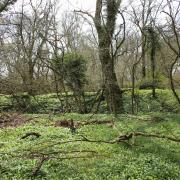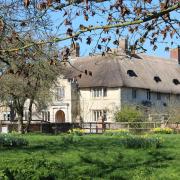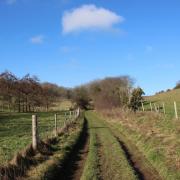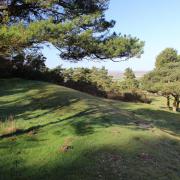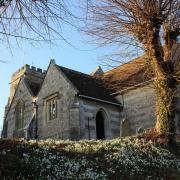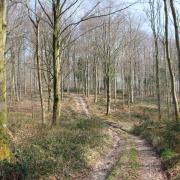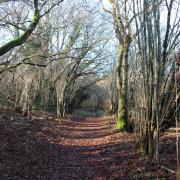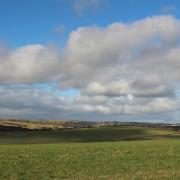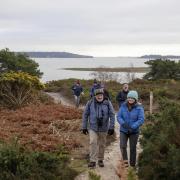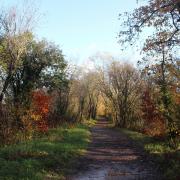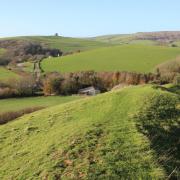From scaling Iron Age hillforts and strolling through a birdwatchers paradise to a walk at dusk to watch the winter stars appear, here are eight fabulous Dorset walks to blow away the cobwebs and show-off this county's wild beauty and fascinating history.
In this mix are walks suitable for little legs and buggies, and gentle strolls with views for older family members
Let’s go fly a kite at Eggardon Hill
Nominated by Sue Dampney of Dorset AONB Team

Eggardon Hill was my favourite. One of seven iron-age hillforts owned by National Trust in West Dorset, it is perhaps the biggest and most elegant of them all. Approach from the south, and you see the vast grassy ramparts laid out along the hilltop – a place to see and be seen when it was built over 2500 years ago. Grassy paths lead you around the hillfort; walk the whole circumference of 1.5 miles or make up your own shorter loop. Follow the ramparts for the most amazing views across the Bride and Brit valleys to the Jurassic Coast – take a picnic mat and flask so you can hunker down and take it all in. Standing at 250m above sea level gives Eggardon Hill has chilly winds with those stunning views, so wrap up warm. Why not take a kite if you have one - this hill was home to an annual Kite Festival for many years! Warm up at the Spyway Inn down the road or pubs in Powerstock and Nettlecombe to the north.

Getting there: Eggardon is just east of Bridport, turn off the A35 towards Askerswell, past Spyway Inn and keep going. Several laybys to park in. Keep dogs on leads as the hill is grazed.
More at dorsetaonb.org.uk/explore and nationaltrust.org.uk/eggardon-hill

A family stroll around Stonebarrow
Nominated by Tom Munro of Dorset AONB
The multitude of walking options at this National Trust-owned site means you can devise a loop of almost any length to suit the time, weather and ability of all involved. A short and level 300m from the western end of the car park takes you to the coastal clifftop, with views across Lyme Bay. Accompanying the panorama, alongside the bird song, the whistling wind rises up from the dense scrub of Cain’s Folly below, between the base of the cliff and the sea. A resident peregrine falcon frequently hunts pigeons around these cliffs. Benches here make it an ideal spot to take those who aren’t up for great exertion; for me it’s an easy viewpoint for taking the air with elderly relatives.
If you’re hankering after a longer leg-stretch, turn to the east here and follow the Coast Path down through Westhay Farm’s clifftop meadows. There are several return options; I usually turn inland at Ridge Barn after crossing two small streams. The streamside scrub and unimproved meadows are rich in wildlife – in a mild winter you can even see wildflowers in the sheltered spots. From here climb steadily up to the ridge-to track at Chardown Hill, turning west to return to the car park.
Take a winter picnic for a fine day, or return to Charmouth with its cafes or pubs.
Getting there: Stonebarrow is just east of Charmouth, turn off the A35 at Charmouth’s eastern junction, and go up Stonebarrow Lane (first left after Newlands Holiday Park). Continue to the end of the lane for a National Trust car park. Keep dogs under close control as the area is grazed.
More at dorsetaonb.org.uk/explore

Ancient echoes at Martin Down & Pentridge Loop
Nominated by Jonathan Monteith of Cranbourne Chase AONB
Jonathan Monteith is an archaeologist and manager of the Chase & Chalke Landscape Partnership Scheme, a National Lottery Heritage Fund programme of projects that aims to better connect people to the landscape of Cranborne Chase Area of Outstanding Natural Beauty (AONB).
I regularly visit here with my children (aged two and six). Parking is easy and we walk across Martin Down National Nature Reserve (NNR), over Penbury Knoll and through the picturesque village of Pentridge. For me, the main draw is walking through a landscape dotted with earthworks which represent thousands of years of human occupation.
From the Neolithic Dorset Cursus, to the ditch and bank of the Bronze Age Grim’s Ditch and Bokerley Dyke, the many Bronze Age burial monuments, the Iron Age hillfort of Penbury Knoll, not to mention the much more recent rifle range butt that was used by the military until the 1950s, this walk takes in the lot.
Our Time Traveller on Cranborne Chase ‘Augmented Reality’ (AR) app, Cranborne AR, has three sites at Martin Down so you can really immerse yourself in the history of this awe-inspiring landscape. The children love seeing and hearing the Roman soldiers shouting as they repair Bokerley Dyke and goading the Bronze Age Ghost Warrior charging across the landscape on his horse.
This is a fantastic winter walk when the low sun casts long shadows against the many earthworks, revealing the rich archaeological heritage of this ancient landscape. There are lots of routes and paths across Martin Down, many of which are accessible with a buggy or tramper. It’s easy to shorten this walk or take more time to enjoy the views. There is one short climb up to Penbury Knoll but generally the going is quite easy.
This circular walk starts at the Martin Down (NNR) car park, near Sixpenny Handley. It’s worth taking a flask of hot chocolate (and a mince pie for the little ones) and waiting until you reach the top of Penbury Knoll before settling down to take in the amazing views and wide-open skies.
Martin Down NNR is an extensive area of internationally important chalk grassland and scrub, nationally important for its rich archaeology and wealth of downland wildlife, including numerous species of butterflies and at least eight species of orchids. Our practical conservation volunteers are working hard to help improve the biodiversity of the site by managing the scrub through our ‘Greater Grazing’. If you’re interested in joining our team of volunteers for this or our other projects, visit cranbornechase.org.uk/chaseandchalke.

Watch a shorter version of this walk on YouTube filmed by Dave Ford and his whippet Logan, search for ‘Walks in Dorset: Pentridge’ and admire some of the ‘finest views in Dorset’
Getting there: Start at Martin Down Car Park, on A354 (Blandford-Salisbury Road). OS Ref: SU037201. W3W Ref:records.necklaces.overruns
More details at cranbornechase.org.uk

Starry, starry nights at Badbury Rings
Nominated by Steve Tonkin
Astronomer, Steve Tonkin is the Dark Skies Advisor at Cranborne Chase AONB which was designated an International Dark Sky Reserve in 2019.
Badbury Rings is a brilliant place to stargaze. It’s safe, easy to park and the Rings offer something extra special after dark in winter - seeing the moon rising, or frost if it’s first thing, glinting on the top of the Rings is spellbinding.
If you start at the National Trust car park it’s easy to see which direction you head in to get in to see the Rings. There are lots of footpaths and bridleways that criss-cross this area, but for an early evening dusk walk to settle down for some stargazing, stick to the area surrounding the Rings. It’s Open Access land so you can wander at will without staying on the paths.
Sit with your back against one of the sides of this Iron Age hill fort as you watch night fall. Pick a clear night. Wear very warm clothes and take something to sit on to stop the dew from seeping in. You don’t need any fancy equipment, your eyes or a pair of binoculars are all that’s needed for this stargazing experience. Don’t forget to take a flask of something hot and some stollen or Christmas cake to enjoy while you watch the wonderful, twinkling show that the winter night sky will put on for you.
For stargazing events at Cranborne Chase AONB visit chasingstars.co.uk
Getting there: Start at Badbury Rings, National Trust carpark off the B3082 (Blandford- Wimborne Road). OS Explorer Map:118 Shaftesbury & Cranborne Chase. W3W Ref: riverbank.language.flattered
More details at cranbornechase.org.uk

Walking Badbury Rings by day
Nominated by Mark Wratten of the National Trust’s Kingston Lacy Estate
This site is rich in history, flora and fauna, which is why I describe Badbury Rings as my ‘happy place’. There are excellent views across the Dorset countryside from the top of Badbury Rings (you can see the Isle of Wight on a clear day). Badbury Rings is one of finest of the Iron Age hillforts in Dorset, and with low levels of light pollution in the surrounding countryside it is also a great place for stargazing.

The Rings and surrounding area are criss-crossed by footpaths, so it’s easy to plan a walk that suits everyone (have a look on the Kingston Lacy website for inspiration nationaltrust.org.uk/kingston-lacy/features/walking-on-the-estate). There’s a large car park on the western side of the Rings (free to NT members, non-members pay £1 for two hours or £3 for the day); from here it’s an easy climb to the top and you can create your own circular walk by strolling around one of the Rings.
There is evidence of Bronze Age and Roman occupation at the site, but it is the Iron Age fortifications that catch the heart; it’s thought the innermost ring dates from around 500-600 BC. If your imagination has been piqued by Badbury, download a guide to some of the other Dorset hillforts in the care of the National Trust here nt.global.ssl.fastly.net/hambledon-hill/documents/dorsets-hillforts-a-visitors-guide.pdf.
Keep dogs under close control around livestock; Kingston Lacy’s pedigree Red Ruby Devon cattle graze the scheduled ancient monument between late spring and autumn, and from March to September there are ground-nesting birds, such as the skylark and corn buntings. Always clean up after your dog, to protect the fragile soils, flora and fauna, and the wellbeing of the livestock.

If you’re feeling peckish afterwards, head down the road to Kingston Lacy itself, where there’s a café, toilets and a 3-mile Woodland Walk for those with energy still to burn!
More details at nationaltrust.org.uk/kingston-lacy

Corfe Common History Walk
Nominated by Ben Buxton of the National Trust
The Corfe Common History walk is a 2.5-mile (4km) circular walk of moderate difficulty starting and finishing in the heart of Corfe Castle village, the 1000-year-old castle ruins providing a constant backdrop. Both Corfe Castle and Corfe Common are cared for by the National Trust.
Suitable footwear will be needed as this route can get muddy in winter, and keep dogs on leads around any livestock Starting at the National Trust Corfe Castle Ticket Office, the route then follows West Street, this was the main street of the village in medieval times.
The route descends gently into the valley of the Corfe River before climbing up to Corfe Common, Dorset’s largest area of common land, an area of open grassland dotted with trees and gorse bushes, even at this time of year some gorse is in flower. Ponies and cattle graze across the common, keeping the flower-rich grassland in prime condition. A team of rangers and volunteers continue the scrub clearance, carried out by generations of commoners, and work to ensure it remains a place of beauty and tranquillity.
There are magnificent views in all directions from the highest point of the common, where there are several Bronze Age burial mounds/barrows dating from around 3,500 years ago. You can also make out the lines of medieval trackways crossing the common, the routes of carts carrying stone from the quarries in the south, to the village and castle.
Once you have completed the walk, why not visit Corfe Castle, between December 27-31 you can step back to the 17th century and join the Lord of Misrule on an interactive journey through the ruins of the castle with games, dances, stories and Christmas traditions of days gone by – not to mention marshmallow toasting over firepits - tours at 10.30am, 11.30am, 1pm and 2pm. Or treat yourself to a traditional cream tea in the 17th century National Trust tearooms.
Getting here: Start from the National Trust Visitors Centre (BH20 5DR) a short 10-minute walk from the village centre (parking charges apply, free for National Trust members). Find detailed walk instructions here at nationaltrust.org.uk/corfe-castle/trails/corfe-common-history-walk or ask a member of staff in the National Trust Ticket Office located just off the village square (BH20 5EZ)
Join the National Trust: Whether it’s sweeping views of coast and country, space to stop and breathe in a beautiful garden or the feeling of discovering hidden secrets in historical homes, treat a special someone to a whole year of unforgettable moments with National Trust membership (£72), or buy it for yourself or your family. Join at nationaltrust.org.uk/membership

Wild winter wonders at Powerstock Common
Nominated by Rob Brunt of Dorset Wildlife Trust
In July 2021 we were thrilled to see DWT’s Powerstock Common designated as part of the new Kingcombe National Nature Reserve. This spectacular nature reserve has so much to offer the winter walker. Once part of the ancient Common of Poorwood, Powerstock Common nature reserve provides ponds, woodland, ancient trees, grasslands as well as a disused railway line and cutting that support a stunning range of wildlife.

In winter, look out for deer, the most common species is fallow, with occasional white individuals, but you may also see roe and sika. Winter flocks of birds can be seen in the tree-tops including siskins in the alders and chattering groups of fieldfares and redwings. Buzzards are frequently seen soaring high above the tree line, accompanied by occasional ‘cronking’ ravens. Pause along the way to take in the ponds that serve as wet wildlife havens all year round. At the northern end of the reserve, you can spot a 19th century Suffolk-style brick kiln.
There is good off-road ‘tramper-style’ wheelchair access by following the forest track and old railway line that forms the much improved three-mile ‘long-trail’. Access to other parts of the reserve is on uneven, often muddy paths so sturdy footwear is recommended. Cattle and Exmoor ponies graze here all year round, so please keep dogs on leads.
Getting there: Situated about three miles west of Maiden Newton, the reserve entrance and parking area is adjacent to a disused railway bridge on a minor road, parallel to and about a mile west of the A356, connecting the B3163 with the A35.

Birdwatching paradise at Upton Heath
Nominated by Hamish Murray, Conservation Officer for Dorset Wildlife Trust
Enjoy fantastic views of Poole Harbour and the Isle of Purbeck from the northern viewpoints on this winter walk. Upton Heath is home to a huge variety of nationally important wildlife, and is a haven for wintering birds including Dartford warblers, stonechats, meadow pipits, buzzards, redwings, long-tailed tits, reed buntings and great spotted woodpeckers.

You can see a good chunk of the east of the reserve in an hour. Paths are generally undemanding but may be muddy, so wear appropriate footwear, and there are a few steep inclines up to the viewpoints. Dogs must be kept on short leads on most of Upton Heath.

To explore the eastern part of the reserve, park on Longmeadow Lane (just off the A35). Enter through a gate at the corner of Longmeadow Lane and Beechbank Avenue. Turn left when you meet a long pathway crossing (called Roman Road, though it isn’t signposted and it is a path). Follow this path south, turning right as you approach the reserve’s south-eastern corner, into a partially wooded area. Take a right where the path splits, then follow the path northeast to a raised former railway track. Turn right on to this path, then quickly left on to a path going north. Close to the top of the reserve, you will find a viewpoint and bench perfect for enjoying a flask of coffee and the view. From the viewpoint, follow the path east, back to the Roman Road, which will lead you to the Beechbank Avenue entrance.
Details and maps for both these walks can be found at dorsetwildlifetrust.org.uk/nature-reserves
Support Dorset Wildlife Trust: Why not join Dorset Wildlife Trust as a member and support their work. Membership starts from £42 per year. More details at dorsetwildlifetrust.org.uk/shop





